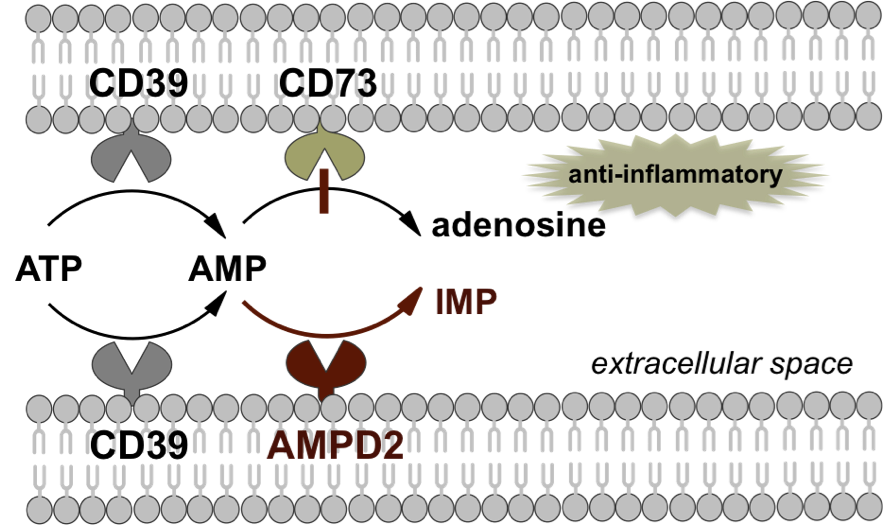Session Information
Session Type: ACR Poster Session B
Session Time: 9:00AM-11:00AM
Background/Purpose: Extracellular ATP and adenosine are potent immunomodulatory molecules that accumulate in states of inflammation. ATP/ADP are released from damaged or stressed cells and sequentially catabolized to AMP which is then catabolized to adenosine by the action of the ectonucleotidases CD39 and CD73, which promotes a shift from an ATP-driven pro-inflammatory environment to an anti-inflammatory milieu induced by adenosine. AMPD2 encodes one of three known AMP deaminase homologs. Intracellularly, it executes AMP deamination to IMP thereby reducing adenosine formation. Here, we postulate that this mode of action is also present on the cell surface of immune cells, which may lead to an increased state of inflammation such as found in chronic inflammatory diseases (Fig. 1).
Therefore, we analyzed surface AMPD2 expression and its modulation on distinct cell lines and primary immune cells.
Figure 1: Model: possible role of surface AMPD2
Methods: To this end, surface AMPD2 expression was evaluated on cell lines (THP1, Jurkat, HMEC1, and HEK293), human PBMCs and isolated monocytes by flow cytometry. Moreover, co-expression of surface AMPD2, CD73 and CD39 was analyzed on PBMCs and isolated monocytes. Association of surface AMPD2 and cell death was visualized using annexin V and 7-AAD staining and examined by flow cytometry. In addition, expression of AMPD2 was analyzed by immunoblot of precipitated AMPD2 from membrane fractions and by mass spectrometry after precipitation from membrane fractions and from biotinylated surface-molecules using the surface AMPD2 positive cell lines HEK293 and HMEC1.
Results: Here, we show that (i) surface AMPD2 is present on T cells and monocytes in PBMCs from healthy donors, (ii) LPS enhances surface expression of AMPD2 in monocytes after 24h whereas AMPD2 surface expression is reduced in T cells treated with LPS and PHA, respectively, (iii) LPS significantly decreases CD73 expression on monocytes in PBMC co-culture, and (iv) all cell lines analyzed are capable of expressing surface AMPD2. Surface AMPD2 expression was significantly reduced after Golgi transport inhibition in both PBMCs and HEK293. AMPD2 surface expression was not accompanied by enhanced cell death. AMPD2, CD39 and CD73 co-staining revealed an opposing expression pattern on lymphocytes and monocytes in PBMC co-culture. Expression of AMPD2 could be confirmed in membrane fractions of HEK293 and HMEC1 using immunoblot of precipitated AMPD2 and mass spectrometry, respectively.
Conclusion: We demonstrate for the first time surface expression of AMPD2 on immune cells enabling these cells to extracellularly convert AMP into IMP constituting a shunt-like mechanism to control the levels of adenosine and extracellular ATP formed from adenine nucleotides thereby controlling immunomodulation.
To cite this abstract in AMA style:
Ehlers L, Kuppe A, Damerau A, Chen Y, Strehl C, Kirchner M, Buttgereit F, Gaber T. Surface Adenosine Monophosphate Deaminase 2 As a Novel Regulator Modifying Ectonucleotidase-Driven Generation of Anti-Inflammatory Extracellular Adenosine [abstract]. Arthritis Rheumatol. 2018; 70 (suppl 9). https://acrabstracts.org/abstract/surface-adenosine-monophosphate-deaminase-2-as-a-novel-regulator-modifying-ectonucleotidase-driven-generation-of-anti-inflammatory-extracellular-adenosine/. Accessed .« Back to 2018 ACR/ARHP Annual Meeting
ACR Meeting Abstracts - https://acrabstracts.org/abstract/surface-adenosine-monophosphate-deaminase-2-as-a-novel-regulator-modifying-ectonucleotidase-driven-generation-of-anti-inflammatory-extracellular-adenosine/

